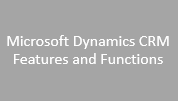Cracking the Microsoft Dynamics CRM Features and Functions Code!
Microsoft Dynamics CRM got really ‘serious’ in CRM version 4. Since 2007 Dynamics CRM has changed significantly and is now on version 2016. This blog seeks to demonstrate those changes as succinctly as possible and demonstrate the capability it now has. One of the most significant changes was the focus from On Premise licensing to Online licensing which Microsoft released in 2011.
The blog signposts resources, videos and release previews which give a great understanding of what Dynamics CRM is all about. Included at the end of the blog are updates on Microsoft Dynamics 365 Sales application and customer service application.


Microsoft Dynamics CRM 2011 to 2013 updates
In 2011 you will see there was a navigate pane on the left hand side where in CRM 2013 a new menu bar replaced that. In 2013 a new ribbon (the line across the top) came into play. We did a round up of all the changes in this blog post called CRM 2013 new features and licensing. with 2013 also came auto save, people photographs, access teams (business units, ownership teams, access teams) as well as command bars and slicker sitemaps. Dynamics CRM v. 4 and 2011 both had pop ups which some users found difficult to work with, however in 2013 came inline editing. This meant that you could now update a record by clicking on it without moving to another screen. This video gives you a little more information about InLine editing in CRM.
With the updates to the 2013 interface also came new Microsoft Dynamics CRM features and functions.
For example, the emergence of social integration using ‘Yammer’, and the biggest functionality change in my opinion was the process bar. The process bar offers visual steps to take for each feature, for example lead management. This helps users to follow actionable steps to progress a lead and has staged gating to ensure that each lead is following the process correctly.
Another great feature of Microsoft Dynamics CRM 2013 was the role-based security teams, whereby restrictions can be set to give teams rights to records with different access levels.
In 2013 there were two releases, Microsoft Dynamics CRM 2013 Spring and Fall.
In the Fall release came more focus on the user experience offering intuitive and actionable intelligence within Dynamics CRM. In the Microsoft Dynamics CRM 2013 release preview guide it demonstrates the “reimagined user experience” with simplified data entry and customer summaries. The process agility keeps users on track and is easily configurable so we can tailor it to your processes and what’s important to you. Mobile and tablet functionality was a focus of Dynamics CRM 2013 as well, keeping users in touch when out and about.
Microsoft Dynamics CRM 2014
In the Microsoft Dynamics CRM 2014 Spring Release preview guide came new acquisitions which were added to Microsoft Dynamics CRM 2013. For example, Marketing Pilot brought Dynamics Marketing, there was also ‘Parature’ and ‘Inside View’. See our blog we did at the time to capture this information about what was new in Dynamics CRM 2013.
The Dynamics Marketing function included personalized email marketing and is included in the Enterprise license. Power BI is also used with Dynamics Marketing to give a full view of the customer using demographics, online behavior overview and marketing reporting tools.
It is important to note here that many of these new acquisitions are only released to the Microsoft Dynamics CRM Online platform and not the On Premise licensing. This has happened with Insights which was provided by Inside View. Inside View is now part of Microsoft Dynamics CRM Online as a professional license, and it enables sales people with ‘data and connections’. The features include:
- Company data to show financials, family trees and industry profiles
- Insights which pulls in company news, social insights over Facebook and Twitter and the ability to target social profiles of decision makers.
- The features also include Connections using LinkedIn and Facebook and sharing for co-workers.
Dynamics CRM 2013 Online also saw the emergence of the Unified Service Desk feature, which is a powerful desktop providing metrics such as:
- Average handling time
- First call resolution
- Customer satisfaction.
The unified service desk feature allows service desk handlers to engage with customers over several channels such as voice, chat and email whilst handling customer sessions simultaneously. All this information can be found in the Microsoft Dynamics CRM 2014 Online Spring release, and this video from Microsoft is a good round up of CRM Unified Service Desk.
With Microsoft CRM Spring 2014 update came another great Microsoft Dynamics CRM Features and Function: Parature, which provides an online 24/7 customer support centre (knowledge management and self-service). Again this is included in the Microsoft Dynamics CRM Online professional license. Parature also comes with a Facebook portal which provides the opportunity for customer service management over Facebook including real-time chat.
In Spring 2014 another major release was the SharePoint and CRM integration. The enhancements were really coming thick and fast!
Microsoft Dynamics CRM Social Listening and Social Engagement
Another huge release in Dynamics CRM 2013 Online (Spring 2014) was Social Listening – now called Social Engagement.
Social Listening measures sentiment and tracks brands, products and influencers across Twitter, Facebook, YouTube, news and forums. This really helps to analyse social usage and how you stack up against the competition giving ability for social campaign management. Again Social Listening was part of the Microsoft Dynamics CRM 2013 professional license with a minimum 5 user count. Today, in 2016, Social Engagement has progressed.
Social Listening measures how much people are talking about you and is a key feature within Microsoft Dynamics CRM. The volume of posts is called “Buzz”. Social Listening offers control to improve customer service and brand perception. It also is able to measure sentiment using a numerical rating between -10 and +10, even measuring sentiment of your competitors. You can set up lists of terms you want to listen for, and collect insightful information so that you can be prepared before contacting someone.
In the 2016 Spring CRM release, there is more exciting functionality released. For example, you can now take a social media post and send it to a case within Dynamics CRM by just clicking a few fields. This really drives customer issues for reporting and resolution. To keep track of the posts you have developed in CRM there is a new filter which shows all linked posts. Direct publishing allows you to post to social media networks straight from Dynamics CRM, and intention analysis and automation rules are also new features that detect customer intent based on the content of the post. Posts can also be sent easily to teams or individuals via Dynamics CRM.
In 2015 social conversations could be listened to in 19 languages. For more information on Microsoft Dynamics CRM Social Engagement see the resources on this link.
In the 2016 release, there is functionality that allows users to search boards, forums and custom sources via RSS including internal non-public sources such as Yammer. Social also moved to role-tailored views to increase sales and service efficiency. Social Engagement has also now extended to Instagram and extended blog coverage beyond Tumblr and WordPress.
Microsoft Dynamics CRM 2015
The Microsoft Dynamics CRM 2015 release preview guide brought new capabilities, functionality and features to deliver amazing customer experiences.
There was a greater focus on Microsoft Dynamics Marketing enabling marketing teams to plan, do and review (using Excel and Power BI), campaigns from start to finish. Another focus was the “guided sales processes” which built on and improved the Microsoft CRM 2013 processes, allowing complex processes using branch selection.
Another new feature added was the ability to add product families to cross sell and up sell as well as the sales hierarchical views. Microsoft continued with the mobile and tablet enhancements and also enhanced the business rules that were released in Dynamics CRM 2013.
Microsoft Dynamics CRM 2016 Features and Functionality
There were 2 releases during 2016. This round up offers the Microsoft Dynamics CRM 2016 release preview guides and a short 2 minute video to help bring the new functionality to life.
This video of Microsoft Dynamics CRM features and functions showcases ‘field service’ and ‘project service’ optimizing staff and resources required for each project, as well as featuring guided user navigation facilities and portals.
The Dynamics CRM 2016 release focused new features on productivity, intelligence, mobility and unified service. SMS was added as a marketing channel. Included in Dynamics CRM 2016 is Voice of the Customer; a new survey feature designed to send out questionnaires and surveys.
The Unified Service Desk improves auditing and diagnostic settings, and an out of the box integration is now offered with any third party systems such as Azure HD Insights. Another feature released to CRM 2016, is the ability to view documents using CRM mobile applications.
An important feature in Dynamics CRM 2016 is Machine Learning (ML), which offers configuration and insights into the CRM interface particularly within social engagement.
The second (Spring wave) Microsoft Dynamics CRM 2016 focused on personalising customer experiences, creating proactive experiences and making customer engagement predictive.
The ADX studio offered web portal functionality into Dynamics CRM Online and pre-configured portals including customer service, community, partner and employee self-service portals which are now available.
Dynamics CRM Field Service video is available here:
Dynamics CRM Project Service video
- Field service is an end-to-end solution which offers scheduling, stock tracking and asset management for service teams and organisations.
- Project service functionality helps to quote, plan and assign resources as well as capturing progress data and expenses.
Server-Side Synchronization now allows you to connect CRM on-premises with Microsoft Exchange Online.
To see the most up to date resources and check out more Microsoft Dynamics CRM Features and Functions, check out the Microsoft Dynamics CRM help and training material guides.
UPDATE: 4.4.17
Please also see our update on Dynamics 365 uncovering what is included in the Microsoft Dynamics 365 Sales App and the Microsoft Dynamics 365 Customer Service App.
More Reading:
Service Scheduling in Dynamics CRM :
CRM Consulting using Caltech CRM :
Get ready for CRM resources
This blog was written by Catherine Carlyle, marketing manager at Caltech IT Limited. We would love to hear from you. Let us know what you think or if you would like a closer look at any of these features or functions.




